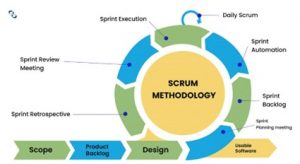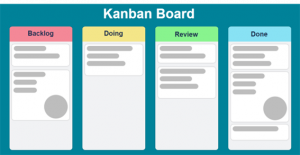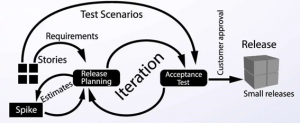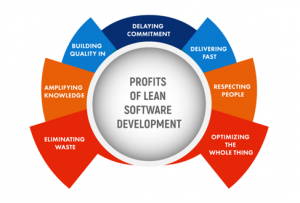Agile went from buzzword to keyword in under 10 years. But what lies ahead for
one of the most effective project management tools around?
Almost 20 years ago, the Agile manifesto revolutionised IT project management. Initially created for software development endeavours, Agile quickly grew to other business areas and industries. In some cases, such as R&D, Operations or Marketing, adoption rates rose to a whopping 80%, as more and more developers, managers and customers gave the nascent methodology a try. Today, Agile is widely regarded as a key project management skill.

The reason behind such growth? As workers around the world have concluded, it actually works. Only 9% of Agile projects fail, as compared with almost 90% of other projects. Agile teams are 25% more productive than non-Agile teams. And 70% of all Agile organizations managed to increase their time-to-market. According to the State of Agile Report, 64% of the respondents said Agile implementation has positively impacted delivery speed and time to market, and 60% saw improvements in team morale and productivity. Now one of the most popular project management methodologies in the world, its reputation only grew during the pandemic, as it enabled businesses to adapt quickly to unplanned remote work.
For all its worth, some have raised concerns that Agile’s success story may be grinding to a halt. The focus on speed and getting to market as quickly as possible, the rise of new methods and high-profile companies shunning Agile have all compounded fears that Agile’s golden age may be behind us. Jeff Bezos famously said he considered himself to be Amazon’s “Chief Slowdown Officer” as he often felt dev teams moved too fast to implementation and coding without a clear product vision and market strategy.
At this stage, it is worth asking whether IT project management methodologies such as Agile arestill relevant, how they canhelp speed up development timeand reduce effort, and how to putthem to use in real-life.
Agile is a project management and software development methodology that focuses on being flexible, collaborative, and responsive to customer feedback. Its essence is working in short, manageable cycles called iterations or sprints, where you constantly check in with your team and your customers to make sure you’re on the right track. It’s all about being able to respond to changing requirements quickly and continuously delivering high-quality software to your users.
The origins of Agile can be traced back to the late 90s when a group of developers realized that traditional project management methods just weren’t cutting it for software development. They were tired of rigid plans that took forever and didn’t allow for any changes along the way. So, in 2001, seventeen of these developers got together at a ski resort in Utah to brainstorm a better way to manage projects.
Over a few days, they hashed out a set of values and principles that emphasized flexibility, collaboration, and delivering small, working pieces of software quickly. This meetup resulted in the Agile Manifesto, a document that laid the groundwork for the Agile methodology we know today.
This manifesto is pretty straightforward. It has four big values:
Basically, this principle prioritizes people and how they communicate over processes and tools. It’s about focusing on teamwork and talking things out.
Instead of spending ages writing documents that no one reads, Agile teams prioritize getting actual software up and running. The idea is to show something that works and improve it from there.
Rather than just sticking to what’s written in a contract (or scope), Agile encourages ongoing collaboration with customers. It’s about working together throughout the project, not just at the beginning and end.
Plans are great, but things change. Agile is all about being flexible and adapting to new information or changes in the project as they come up.
These values were supported by 12 principles, all aimed at helping teams be more effective and responsive.
Customer satisfaction: The top priority is to make customers happy by delivering valuable software early and continuously. It’s like giving them little pieces of the puzzle as you go, so they see progress and get value right away.
Welcome change: Don’t be afraid of changing requirements, even late in the project. Agile embraces change to give customers a competitive edge.
Frequent delivery: Deliver working software frequently, usually every few weeks to a couple of months. It’s like having regular check-ins where you show what you’ve done and get feedback.
Collaboration: Developers and businesspeople must work together daily. It’s all about teamwork and making sure everyone’s on the same page.
Motivated teams: Build projects around motivated individuals. Give them the environment and support they need and trust them to get the job done.
Face-to-face conversation: The best way to convey information is through face-to-face conversation. In other words, talk to people directly whenever you can – it’s faster and clearer.
Working software: The primary measure of progress is working software. Forget about all the fancy reports and charts; if the software works, you’re making progress.
Sustainable development: Agile processes promote sustainable development. The team should be able to maintain a constant pace indefinitely.
Technical excellence: Continuous attention to technical excellence and good design enhances agility. It’s doing things right from the start to avoid headaches later.
Simplicity: Maximize the amount of work not done. Essentially, keep things simple and don’t overcomplicate. Focus on what’s really necessary.
Self-organizing teams: The best architectures, requirements, and designs emerge from self-organizing teams. Let your team figure out the best way to work together and solve problems.
Reflection and adjustment: At regular intervals, have your team reflect on how to become more effective. Then, adjusts behaviour accordingly.
Agile frameworks offer different ways to put Agile principles into action, each with its own set of practices and strengths. Choosing the right one for your team can make a big difference in how smoothly your projects run.

Source: Stack Academy
Scrum is one of the most widely used Agile frameworks. It breaks projects into manageable chunks called sprints, typically lasting 2-4 weeks. During each sprint, the team works on a set of prioritized tasks from a product backlog. Scrum emphasizes roles like the Product Owner, Scrum Master, and Development Team, and includes regular meetings such as daily standups, sprint reviews, and retrospectives.
When to use: If your project benefits from a structured approach with clear roles and frequent progress checks, Scrum might be a great fit.

Source: Wikimedia
Kanban focuses on visualizing work and managing flow. It uses a Kanban board to track tasks through various stages, from “To Do” to “Done,” and emphasizes limiting work in progress (WIP) to prevent bottlenecks. Kanban is flexible and allows for continuous delivery, making it ideal for teams needing to manage ongoing work or those with varying priorities.
When to use: If you’re looking for a method that’s less about fixed iterations and more about maintaining a steady flow, Kanban could be the way to go.

[Source: LinkedIn]
Extreme Programming, or XP, is all about technical excellence and frequent releases. It includes practices like test-driven development (TDD), pair programming, and continuous integration. XP aims to improve software quality and responsiveness to changing requirements.
When to use: If your project requires strong technical practices and frequent feedback loops to refine the product.

Source: European Business Review
Lean Software Development borrows principles from Lean manufacturing, focusing on eliminating waste and maximizing value. It values practices like optimizing the flow of work, delivering in small batches, and empowering teams to make decisions.
When to use: If your goal is to enhance efficiency and deliver high value quickly, Lean could be the framework to consider.

Source: Maya Jaber
SAFe is designed for scaling Agile practices across large organizations. It provides a structured approach to coordinate multiple teams and align their efforts with organizational goals. SAFe integrates Agile with Lean and product development flow principles.
When to use: If you’re working in a large organization with multiple teams and need a framework that supports coordination and alignment at scale, SAFe might be the right choice.
Many teams struggle to transition from traditional methods to Agile. However, by following these key practices, they can make the shift effectively and thrive with structure.
To get Agile working smoothly for your team, begin by defining a clear vision and goals for the project. You need to know where you’re headed and what success looks like to keep everyone on the same page.
The next step is deciding which Agile framework to use. Keep these factors in mind:
Assemble teams that bring a diverse mix of skills and expertise to the table. Encourage collaboration and make sure everyone shares their knowledge openly to maximize the team’s effectiveness.
Embrace iterative development by breaking the project into smaller, manageable portions, typically lasting 2-4 weeks. Each iteration should produce a working piece of the product, allowing you to gather feedback and make improvements as you go.
Make customer feedback a priority by engaging with your customers and stakeholders regularly. Continuous feedback ensures that the product aligns with what the customers actually need.
Keep a product backlog that lists all the tasks and features you need to work on, prioritized by what’s most important. This acts as your project’s to-do list. Regularly review and refine the backlog to reflect changes in priorities or new insights.
Organize regular meetings to keep everyone aligned. Daily standups are great for quick updates on progress, roadblocks, and plans for the day. Sprint planning meetings help you decide what to tackle in the upcoming sprint, while sprint reviews are your chance to showcase what you’ve accomplished and gather feedback. Don’t forget sprint retrospectives, where you review what went well and what could be improved to tweak your approach for the next round.
Keep communication open and transparent. Use tools and practices that support clear information sharing among team members.
Create a collaborative culture where teams feel empowered to make decisions and solve problems on their own. Encourage innovation and be open to experimenting with new ideas. A supportive environment helps team members feel more engaged and invested in their work.
Prioritize technical excellence by adopting best practices like coding standards, automated testing, and continuous integration. Regularly refactor code to keep it clean and adaptable. This ensures that your software remains high-quality and can evolve smoothly over time.
Be prepared to handle changes effectively. Agile thrives on adaptability, so be ready to adjust to shifts in requirements or market conditions. Communicate any changes clearly to minimize disruption and keep the team on track.
Use metrics like velocity, burn-down charts, and cycle time to keep an eye on progress and team performance. These metrics help you gauge how well the project is going and identify any areas that need attention. Use the data to make informed decisions and adjust your practices as needed.
Invest in training and development to keep your team up-to-date with Agile practices and tools. Provide opportunities for learning and offer mentorship and support to help everyone grow and adapt. Continuous learning ensures that the team remains skilled and effective.
There is little doubt that it is currently one of the most effective project management frameworks around. It is, however, not impervious to change.
In the next few years, we are likely to see Agile project management shift towards even greater customer collaboration, with organizations involving customers and stakeholders throughout the project lifecycle to gather feedback and refine requirements in real-time. This customer-centric approach ensures that the final product meets the evolving needs and expectations of the end-users.
Agile methodologies are also increasingly incorporating DevOps practices, which enable continuous integration, delivery, and deployment of software. This integration allows for seamless collaboration between development and operations teams and improved overall efficiency and quality throughout the software development lifecycle.
There is a third avenue for growth, as the methodology evolves to address the challenges of scaling to larger projects and organizations. Various frameworks such as Scaled Agile Framework (SAFe), Disciplined Agile Delivery (DAD), and Large-Scale Scrum (LeSS) have emerged to provide guidance on scaling Agile, allowing organizations to coordinate and align multiple Agile teams working on interconnected projects.
These changes empower organizations to deliver value to customers faster, adapt to changing requirements more effectively, and improve overall project success rates. Still, culture plays a decisive role. To truly solve problems and be ready for quick shifts, you must first understand the culture and mindset behind this methodology. The practices behind Agile are just the system that sustains and supports agility in the long run.
For all its advantages, many companies still face challenges in Agile adoption. Key pitfalls include unengaged leadership, unclear priorities, or just simply not understanding what it does (also reticence to change / closed mindset). The change in an organisation needs to start from the top, and leadership needs to be the guiding light of that change.
Organization coaching, by giving internal training, is a great way to get your employees and organization more familiar and comfortable with Agile vocabulary and methodologies across all departments. At Near Partner, between May and September 2023, our 2 certified Scrum Masters (PSM I), Laetitia and Nelson, gave internal training to all our employees, from developers to marketing and sales departments, about Agile methodologies, more specifically Scrum and Kanban – which are the most used in our projects.

Laetitia and Nelson facilitating Agile training
Core concepts about Scrum – like Scrum foundations, values, team roles and ceremonies – and Kanban principles were presented during this training. Interactive group exercises enabled our Partners to confront their ideas and consolidate their knowledge and were highly liked. Sharing real-life project scenarios and explaining the topics from the basics helped everyone, especially for who never has been in contact with Scrum, to be on the same level at the end of the training.
The feedback collected was really positive as 96% of the respondents learned something new and 80% rated the session as useful, being able to apply the concepts they learned in their project or to enhance their way of working.
Is your organisation ready to take the next step? At Near Partner, our teams undergo regular Agile training to be able to adapt and incorporate the latest changes in the methodology.
Get in touch with Near Partner and let us figure out how we can help your business.